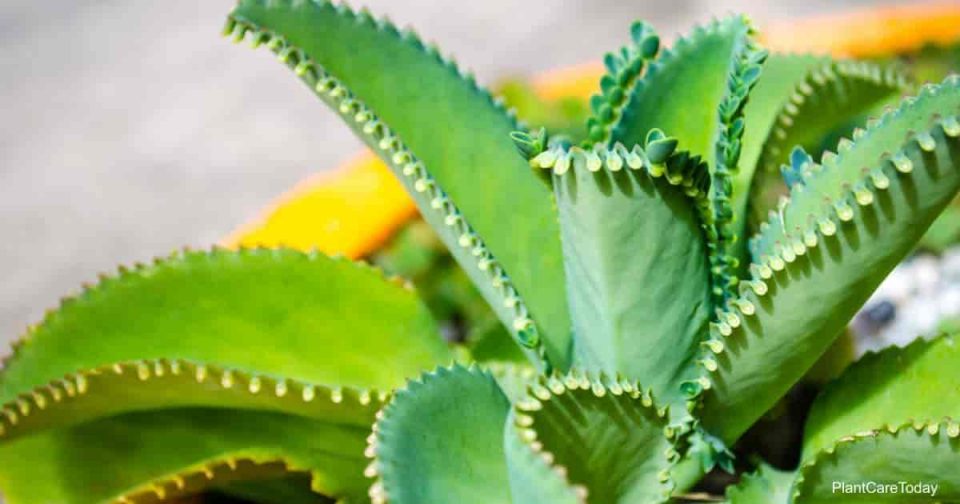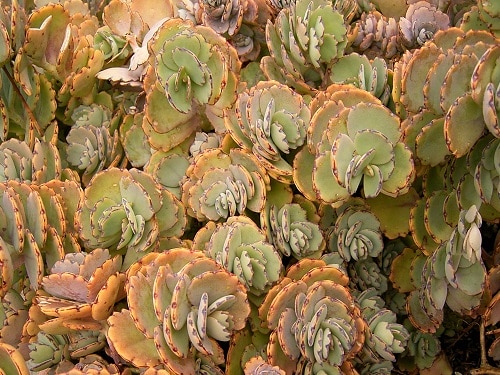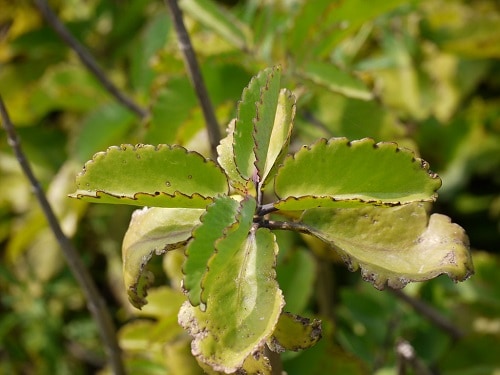‘Mother of Thousands’ plant whose scientific name is Kalanchoe Daigremontiana is a not so common Succulent that belongs to Madagascar. It is also known as the Alligator plant, Mexican Hat Plant, and the Devil’s backbone which is a part of the Crassulaceae Family. The large pointed blue-green-colored leaves grow up to 6 inches long and 3 inches wide. The leaves of the plant develop small plantlets at the edges of the leaves and they drop quite easily from the main plant. These plantlets have a tendency to root anywhere they fall if they find the right soil for growth and multiply themselves and this is why is it called “Mother of Thousands” plants.

The slow-growing subtropical plant is easy to care for but you have to take care of the falling plantlets as they can grow in some other pot as well if you keep them together indoors. The plant is particulate good if you grow it outside as they do not flower when grown inside. When you grow the plant outside you can expect it to grow small pinkish-gray flowers during the warm season. The plant is good for novice gardeners to care for, grow and propagate after some time.
‘Mother of Thousands’ Plant Care
- Water: The mother of thousands plant is a drought-tolerant plant and it can withstand dry conditions quite easily. The plant needs only a few watering sessions like once every one to two weeks during the summers. Although they need consistent watering sessions, they can manage if you forget to water them sometimes. During winters, reduce the watering sessions as it may cause limp leaves. Water only when a few inches of the soil feels dry.
- Soil: Just like every other succulent, the mother of thousands plant requires a well-drained potting mix. The plant cannot tolerate standing water in the pot. You can make perfect soil for your plant by mixing, sand or perlite along with cactus mix and regular potting soil. Pertile will enable the drainage of water and improve air circulation within the soil. The potting mix will retain the water for some time to feed the plant water for optimal growth.
- Light: During the warmer period of year place the plant in bright indirect light as the strong direct light may scratch the delicate leaves of the plant. They can enjoy the bright direct light during the morning when the sun is not too hot. During winters, when the sun is not too hot, you can put the plant in direct sunlight from where it can get an adequate amount of heat to grow.
- Temperature & Humidity: The temperatures between 16 to 24-degree celsius are good for the plant. Cold temperatures cannot be tolerated by the plant and never put them in a place where the temperature falls below 4 degrees celsius. The plant enjoys low to medium humidity and normal room temperatures are good enough for them to thrive. Even at homes during the winter period, put them away from direct heat as it may dry the plant.
Popular ‘Mother of Thousands’ Varieties

Bryophyllum Gastonis-bonnieri (Kalanchoe Gastonis-bonnieri):
The plant is commonly known as good luck leaf, Miracle Leaf, Sprout Leaf Plant, and Palm Beachbell. The plant has waxy red candelabras with one of the biggest leaves with light green colored foliage.

Bryophyllum Fedtschenkoi (Kalanchoe Fedtschenkoi):
The plant is even known as the South American air plant, Lavender Scallops, and Gray Sedum. It is a tropical plant that has metallic green leaves and bell-shaped purple or reddish-brown flowers.

Bryophyllum Pinnatum (Kalanchoe Pinnata):
The plant has so many common names like Life plant, Miracle Leaf, Air Plant, and Goethe Plant. The plant gets its name Goethe Plant by a writer whose name was Johann Wolfgang von Goethe. He was really interested in this plant species and he used to give everyone a plant whenever any guest visited his home.
‘Mother of Thousands’ Propagation
It is very easy to propagate the plant from the plantlets. The Plant usually drops the platelets during the time when it is not actively growing. It becomes really easy to detach the platelets from the leaves without even applying any pressure. Put the plantlets on the well-drained, damp soil and it will start growing eventually. Do water them regularly as per their needs and provide adequate light for optimal growth.
Mother of Thousands Benefits
- Conserve Water: The mother of thousands plants have the properties of conserving water inside the leaves. Whenever there is a shortage of water like in the dry period or if there are no rainy days for a long time, they use the stored water for survival. So, you do not have to worry much about the watering sessions.
- Medicinal Uses: Some research has been made that concluded this plant has anti-inflammatory, antimicrobial, and anticancer characteristics. The plant is believed to be helpful in healing wounds and other problems like a cough. The plant is even used to produce commercial drugs.
- Absorbs CO2: Unlike most of the plants that release carbon dioxide at night, the mother of thousands plants has the property to absorb CO2 at night and produce more oxygen later. This even makes it a good oxygen generator plant.
‘Mother of Thousands’ Vs ‘Mother of Millions’
Mother of thousands and mother of millions are quite similar in many properties and they are often confused with one another. The major difference between these two plants can be found in the leaves. Mother of thousands plants has wide leaves where plants grow along the edges of the leaves. Mother of millions of plants have narrow leaves and the plantlets grow at the tip or at the end of the leaves.
Frequently Asked Questions
Q1: Is the ‘Mother of Thousands’ plants toxic to humans and pets?
The leaves, plantlets, and stem of the plant are toxic and it can be fatal for children and pets.
Q2: Why do the leaves of my ‘Mother of Thousands’ plant curling or turn yellow?
If the leaves are curling and turning yellow it may be happening due to excessive water in the roots.
Q3: Is the ‘Mother of Thousands’ plants attacked by pests or diseases?
The plant is rarely attacked by pests and diseases if you care for the plant and keep it in the best possible location.
